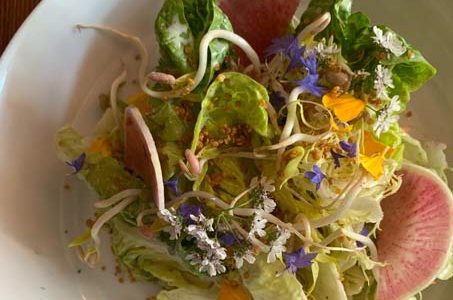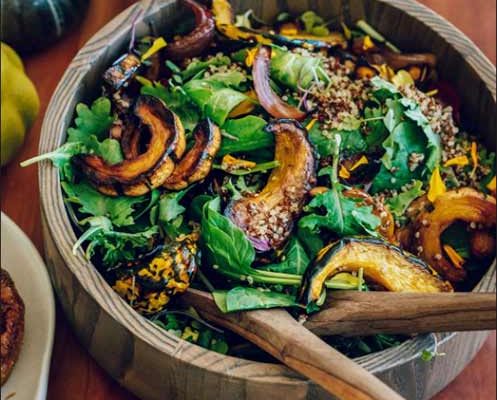How we evaluate menus to find the best food that’s healthy, delicious, and sustainable.
Calling all 'menu pros'
When deciding what or where to eat, many of us scope the menu first.
After analyzing hundreds of menus over the past few months, we’ve noticed sometimes what’s on a menu – and not on a menu – can speak volumes.
Here are three key considerations to keep in mind for your next menu review.
#1 Sourcing
Sourcing is one of those details you don’t always see on menus. But when you do – and when you can verify local producers are involved – it’s a great sign you’re on the right track!
Proximity significantly impacts the quality of fresh ingredients like produce, not to mention the carbon footprint. Produce close to the source is fresher, has a higher nutrient content, and simply tastes better!
So yes, look for that salad that’s as close to fresh-picked as possible!

Knowing the farming and production practices of the ingredients is important.
Smaller local operations following regenerative practices are best. Commercial operations – even organic – tend to use monocropping, where the same crop is replanted on the same land season after season, without providing healthy biodiversity or allowing the soil a needed break. This degrades soil quality and crop nutrients and calls for more inputs to keep producing, part of a vicious cycle.
When farms are following regenerative or biodynamic practices closer to the ‘true’ spirit of organics, they’ll use animals, crop rotation, and/or nitrogen-fixing cover crops to provide the needed biodiversity and natural soil restoration.
Where sourcing practices aren’t clear, we ask. e.g. Is everything produced by organic or biodynamic practices? Who are the local producers and purveyors? Is the restaurant minimally sourcing the ‘dirty dozen’ produce ingredients per organic or biodynamic practices?
Having the assurance of knowing that herbicides, pesticides, and fungicides were not applied to the food you’re eating is important – not only for your body but also for our planet. As Matthew Guelke of The Plant Cafe Organic, a 100% organic cafe in San Francisco says, “It’s just as important to know what’s NOT in your food as it is to know what’s in your food..”
“It’s just as important to know what’s NOT in your food as it is to know what’s in your food”
— Matthew Guelke, co-owner of The Plant Cafe Organic, San Francisco, CA
Which leads to the next factor…
#2 Ingredients
When it comes to ingredients, consider the ‘healthfulness‘ of dishes, IE nutrient-density and anti-inflammatory properties.
As noted, nutrition can be depleted by commercial production and transport. That aside, seek a wide variety of beautiful, brightly colored vegetables and produce. The more diverse the better. (your gut will thank you!) Maximize liberal leafy vegetables when possible. Diversity in raw vs cooked is great too.
In addition to healthy vegetables, we like to see at least one good fish option or healthy protein from a mix of legumes or nuts and brown rice. We steer away from other meats unless they’re organic and exclusively pasture-raised, per biodynamic or regenerative practices. (Bring on that pastured heritage bird or fresh pasture-raised eggs!)

Selecting a healthy fish can be a fishy business. Wild Alaskan salmon or king salmon are go-tos for the West Coast. Absent these, we consult Monterey Bay Aquarium’s best practices for sustainability and research the potential for mercury or other contaminants. The latter is usually based on size, so ‘small and wild’ tends to yield less contamination, so long as the fishing method is sustainable.
Did you know? Fishy business…Not all seafood’s so ‘healthy’?!
We look at tradeoffs between optimal omega-3 levels, lower mercury & contaminants, and sustainability of fishing practies.
And as our oceans change, everything’s in flux. Today’s sustainable fish may not be sustainable in a year or two. And sometimes farmed seafood is actually preferred to wild seafood (as in the case of oysters and other bi-valves)
Beyond these core ingredients, pay attention to the quality of oils and spices used.
We also seek simplicity. Higher-quality core ingredients require less fuss and fewer other ingredients.
Which brings us to our 3rd and final consideration…
#3 Preparation
When considering “healthy” preparation, you might start with the basics: Are any dishes steamed, poached, grilled, etc? Are they smothered in heavy sauces or heavily oiled or salted?
Beyond that, balance is big.
Are dishes meat-focused or plant-forward? Is there nutritional balance in the dishes or amongst what you might put together? Is there a good variety and appeal of colors, textures, flavors, and nutrition?
And if you choose a more indulgent main dish, are there ample healthy small plates or vegetable sides?
Aim for vegetables and leafy greens to be the focus with modest amounts of sustainable animal protein (3-4 oz) or balanced whole-food plant protein such as organic tofu, grains and legumes, or grains and nuts.
This often means supplementing main meat dishes with a number of vegetable starters or sides.
Don’t forget – if portion sizes are generous, leftovers are your friend! Stash half or more as needed to enjoy over a few meals.
Don't forget those who need you now
Be sure to patronize the wonderful healthy, sustainable, and delicious restaurants, cafes, meal services and more near you.
While delivery has dominated, please know it’s typically not the preference of the small local businesses who need your support more than ever.
Order large, tip well, and opt for takeout over delivery as much as possible (or dine on-premise, where allowed and safe).
We're bringing together the best healthy eats near you.
You’d be hard-pressed to find anyone asking all the questions we do. We do all that digging, so you don’t have to!
Our members-only web app features the best places offering healthy, sustainable, and delicious food. Check out our celebration of good food and subscribe to access our ever-growing, live Collection. If you’re not in our current coverage area, get on our priority access list.
Visit our sign-up link for more info.
Discover the best healthy, sustainable, and delicious food near you.
Healthy Anywhere
Conscious. Clean. Curated.™

